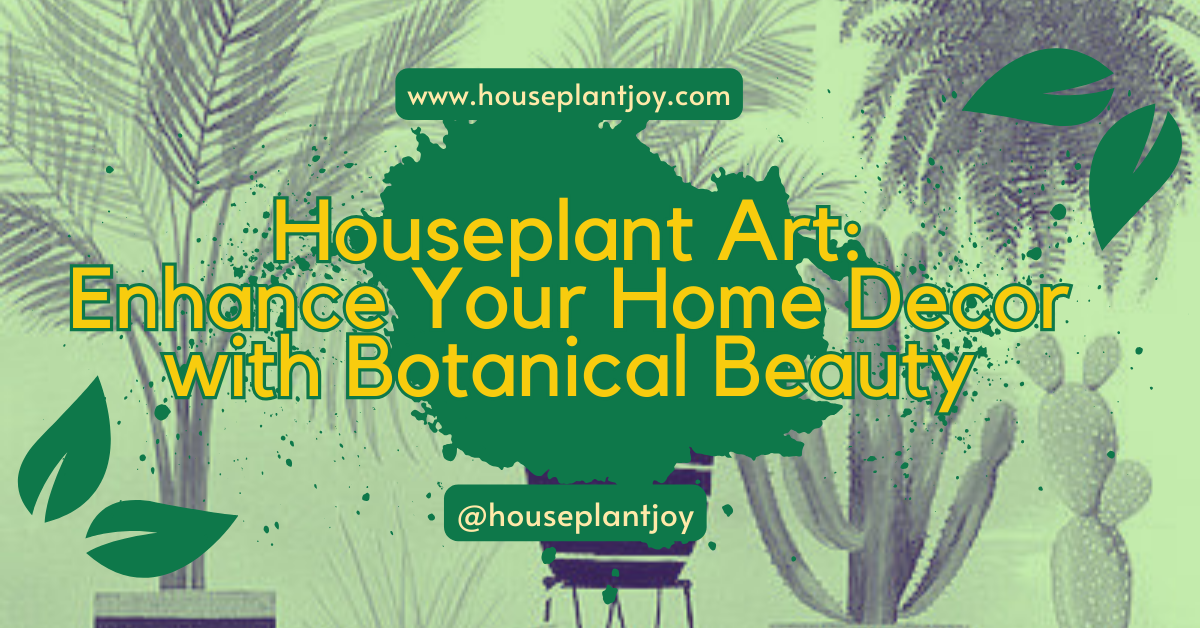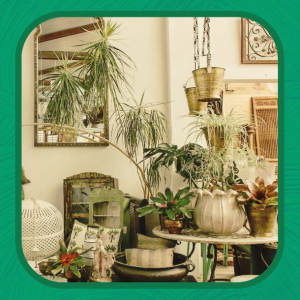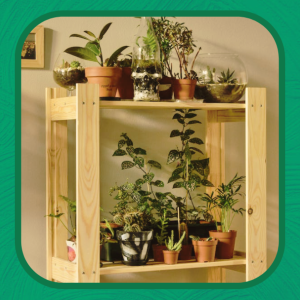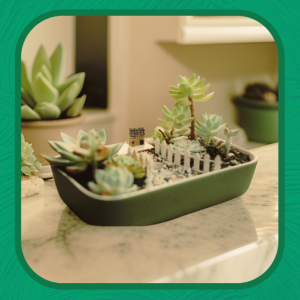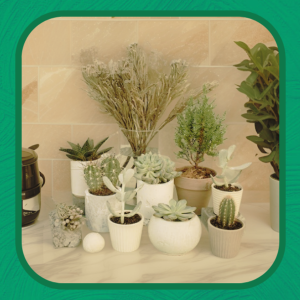HousePlantJoy is supported by our audience. When you purchase through one of our links, we may earn a small affiliate commission. As an Amazon Associate I earn from qualifying purchases. Your cost is not affected.
==================
Transforming your home into a botanical haven elevates your decor aesthetic and improves your mental well-being. Houseplant art creatively incorporates foliage and greenery within living spaces, changing the atmosphere from simple to lively with a touch of nature. By introducing plants into your home decoration, you not only add color and texture but also can create an environment that feels refreshing and vibrant.
Houseplant Art: Enhance Your Home Decor with Botanical Beauty
Understanding the best ways to integrate plants into your home requires a balance of aesthetics, functionality, and plant care knowledge. Whether you are trying to achieve a minimalist, bohemian, or modern look, selecting the right plants and containers is crucial to harmonize with your interior design. It’s about finding that sweet spot where form meets function, ensuring your plants are decorative and thrive in their environment.
Key Takeaways
- Plants enhance home decor, offering visual interest and health benefits.
- Appropriate selection and placement are key to harmonizing plants with your home style.
- Container choice and plant care are essential for the longevity of your houseplants.
Understanding Houseplants
Incorporating houseplants into your home decor enhances aesthetic appeal and requires you to understand the essentials of plant care, the types of common houseplants, and the benefits they bring to your indoor environment.
Essentials of Plant Care
Light: Every plant has specific light requirements ranging from low to bright indirect light. It is crucial to place your plants in an area that best suits their needs.
Water: Overwatering is a common mistake. Ensure you’re familiar with the watering schedule for each plant, as this varies widely.
Soil: The right soil type is imperative for drainage and nutrient retention. Use a potting mix suited for the plant species you own.
Temperature and Humidity: Most houseplants thrive in temperatures between 65-75°F (18-24°C) and with higher humidity levels. Be mindful of the conditions in your home.
Identifying Common Houseplants
- Snake Plant (Sansevieria): Known for its tall, upright leaves.
- Spider Plant (Chlorophytum comosum): Recognizable by its arching leaves and small plantlets.
- Peace Lily (Spathiphyllum): Features glossy leaves and white flowers.
- Fiddle Leaf Fig (Ficus lyrata): Has large, distinctive violin-shaped leaves.
Benefits of Indoor Plants
Air Quality: Plants like the snake plant contribute to better air quality by filtering toxins.
Mental Well-being: Studies show that plants can reduce stress and enhance mood by bringing a piece of nature indoors.
Focus and Productivity: The presence of plants may also boost concentration and productivity, making them a good addition to workspaces.
Design Principles for Plant Decor
Integrating houseplant art into your home requires thoughtful consideration of design principles to ensure harmony and aesthetic appeal.
Color and Texture in Plant Selection
Choose plants with colors that complement your existing decor. For example, a peace lily’s oven-white flowers can enhance a minimalist monochrome scheme, while the lush green of a fiddle leaf fig adds vibrancy to a neutral palette.
The texture is equally important. Consider the fine feathery fronds of a fern to contrast with the smooth surfaces of modern furniture.
Balancing Space and Scale
Your plant choices should align with the available space. Large plants can overwhelm a small room, making it feel cluttered.
Conversely, small plants in a large, open space may seem lost. It’s about getting the scale right. Tall, architectural plants work well in spacious rooms, while a collection of smaller plants can create interest on a shelf or window sill.
Creating Focal Points with Plants
Plants can be natural focal points in a room. Strategically place a striking monstera at a corner to draw the eye or use a series of hanging plants to guide the gaze upwards. Remember, the goal is not to overcrowd the area but to create a visual journey within the space.
Incorporating Plants into Various Home Styles
Whether you live in a sleek city loft or a cozy country cottage, integrating houseplant art into your home decor can enhance your space’s aesthetic and ambiance. Here’s how you can tailor plant choices and displays to complement various interior design styles.
Modern and Minimalist Interiors
In a modern and minimalist setting, your focus should be on achieving a clean and structured look. Opt for plants with architectural shapes and distinct lines, like the snake plant or the ZZ plant. Position these in simple, geometric pots or planters.
Creating groupings of one plant species can make a strong statement while maintaining the uncluttered aesthetic that is a hallmark of this style. When considering botanical art, choose pieces with minimalist designs that complement the simplicity of the space.
Bohemian and Eclectic Spaces
Bohemian and eclectic interiors welcome a more laid-back and playful approach to decorating with plants. Incorporate a variety of species that feature different textures, sizes, and colors. Consider hanging plants like pothos or spider plants, which can add vertical interest and are particularly suited to the bohemian style.
Plants with vibrant foliage or flowering types can add pops of color. Using unexpected planters like recycled objects or colorful ceramics can enhance the eclectic vibe.
Traditional and Classic Environments
For more traditional spaces, choose lush and full plants, such as ferns or peace lilies, to complement classic decor’s rich textures. Symmetrical arrangements are key in these settings, so consider placing matching plants on either side of a mantel or doorway.
Incorporate plant stands or ornate pots to align with the sophisticated nature of traditional styling. Remember to allow your plants to blend with the room rather than stand out to maintain the elegance and continuity of the traditional style.
Selection and Placement of Plants
Selecting and positioning your houseplants effectively can transform the appearance and feel of your space into a dynamic display of houseplant art. Careful consideration of each plant’s needs and aesthetics will ensure your home decor is vibrant and cohesive.
Choosing the Right Plant for Each Room
Light: Begin by assessing the natural light in each room. Low-light tolerant plants like the ZZ plant or snake plant are perfect for dim hallways or bathrooms. Alternatively, rooms with ample sunlight accommodate sun-loving plants such as succulents or cacti.
Humidity and Temperature: Be mindful of the room’s climate. Bathrooms with higher humidity are ideal for tropical plants like ferns or peace lilies. Keep temperature-sensitive plants like orchids away from drafts and ensure they are placed in stable environments.
Size and Growth: Account for your plants’ growth pattern and mature size. Spacious living areas can host larger plants like fiddle leaf figs, while smaller spaces may be better suited for compact plants like aloe vera.
Utilizing Vertical Space
Maximize your vertical space to create a dynamic display. Here’s how:
- Hanging Planters: Suspend plants like English ivy or Boston ferns to add height and draw the eye upward.
- Shelves and Mantels: Utilize these areas for small potted plants; rotate them regularly to ensure consistent light exposure.
- Wall-Mounted Planters: Choose plants that thrive in these settings, perhaps a variety of potted herbs in the kitchen for both decor and functionality.
By embracing the vertical dimension, you conserve precious floor space and add an engaging layer to your indoor landscape.
Grouping Plants for Visual Impact
Design visually interesting plant groupings by considering the following:
- Texture and Form: Combine plants with varied leaf textures and shapes. For example, pair a monstera’s broad leaves with the fern’s delicate fronds.
- Color: Different shades of green create depth, while flowering houseplants add a pop of color.
- Height Variation: Use plant stands or differently sized pots to create levels that draw the eye through the space.
Remember, group plants with similar care requirements to make maintenance easier. A well-curated plant arrangement can act as a living piece of art in your home.
Video Credit: @JulieKhuu
Plant Care and Maintenance
Caring for houseplants requires understanding their specific needs for water, light, and regular grooming. These basic practices will ensure your houseplant art’s health and aesthetic appeal.
Watering Techniques
You should familiarize yourself with the water requirements of your plants because overwatering and underwatering can both be harmful. Use a finger test to check the soil moisture.
If the top inch is dry, it’s time to water. Alternatively, the bottom-watering method can help encourage root growth, where you allow the plant to soak up water from a tray.
Lighting and Temperature Control
Proper lighting is critical for plant health. Most houseplants thrive in bright, indirect light, though some may need partial shade.
Consistency in the temperature is equally important. Keep your plants away from drafts and avoid temperature fluctuations by placing them in a stable environment, generally between 65-75°F (18-24°C) during the day and slightly cooler at night.
Pruning and Upkeep
Regular pruning promotes new growth and removes dead or yellowing leaves, which can be a sign of stress in a plant. Always use clean, sharp scissors or pruning shears for clean cuts. Remember to wipe down leaves with a damp cloth to remove dust and inspect for pests, ensuring your plants can breathe and absorb light efficiently.
Container and Planter Creativity
When it comes to transforming your space with houseplant art, the containers you choose are as crucial as the plants themselves. Creative planters house your plants and enhance your home’s aesthetic.
DIY Planter Ideas
You have endless possibilities when crafting DIY planters. One approach is to repurpose common household items such as tin cans, mason jars, or even old boots, giving them a new lease on life as quirky plant holders. Decorative painting or adding a fabric wrap can tie these DIY planters into your room’s color scheme.
Mixing and Matching Containers
Consider mixing and matching containers of varying materials like ceramic, metal, and wood for a dynamic visual impact. Playing with different textures and colors creates a layered look that adds depth to your space. Remember to maintain a cohesive aspect by sticking to a consistent color palette or design theme.
Utilizing Unconventional Planters
Think outside the pot. Unconventional planters, such as lab beakers or shadow boxes, can serve as eye-catching display pieces. They offer a unique twist and can be particularly fetching when placed in unexpected areas of your home, like a wall shelf or a desk corner.
Overcoming Challenges
Incorporating houseplants into your home decor enhances your living space, but you may face certain challenges. Understanding how to manage these issues will ensure that your houseplant art thrives.
Dealing with Limited Space
If your living area doesn’t allow for large planters, consider vertical gardens or hanging planters. Utilizing wall space with floating shelves can vividly display your plants without consuming valuable floor space. Mounting potted plants on the wall or hanging them from the ceiling optimizes your area and brings life to every corner.
Addressing Common Pests and Diseases
Plants can sometimes bring unwanted guests like aphids or spider mites. To tackle this, ensure that you regularly check your plants for signs of pests and treat them promptly with insecticidal soap or neem oil.
Proper air circulation and avoiding overwatering are key preventive measures for diseases such as root rot or powdery mildew. For added protection, consider using a diatomaceous earth barrier.
Choosing Low-Maintenance Plants
Your busy schedule may not allow for high-maintenance foliage. Select plants known for their resilience, like snake plants or ZZ plants.
These types of plants require minimal watering and are tolerant of various light conditions, making them ideal for a low-maintenance garden. Remember, the right plant choice makes a significant difference in sustainable houseplant art.
Wrapping It Up
In summary, houseplants are more than just greenery. They bring life and art to your home. Mix different sizes and shapes for variety.
Consider the light and space each plant needs. Don’t forget to water and care for them. With a little love, your plants can transform any room. Create your own botanical haven and enjoy the beauty!
Frequently Asked Questions
How can you effectively integrate plants into your home’s interior design?
To effectively integrate plants into your home’s interior design, focus on matching the right plant with the appropriate space. Consider houseplant art as a creative approach to enhance your decor.
Choose plants that complement your room’s color palette and place them in areas that enhance the room’s balance and symmetry. Consider expert tips for designing with plants for more ideas.
What are some of the best indoor plants to use in modern decor?
The best indoor plants for modern decor often have clean lines and a minimalist aesthetic. Species like the Snake Plant, Monstera, and various types of succulents work well.
These plants blend perfectly with contemporary furniture and settings. Explore unique options on Etsy’s collection of indoor plants.
What strategies can be employed to decorate a living room with plants?
Decorate your living room with plants by adding them as living statements. Large plants can serve as focal points, while smaller plants may accent shelves and tables.
Utilize hanging plants to draw the eye upward and add depth. Reference Homes & Gardens for ways to display house plants.
How can you decorate your bedroom with plants to enhance the space’s ambiance?
Use plants in your bedroom to create a tranquil and restful ambiance. Place plants on nightstands, windowsills, or hang them from the ceiling to not take up floor space.
Opt for species that release oxygen at night, like the Peace Lily. For bedroom decoration inspiration with plants, check out suggestions from Veranda’s guide.
What are the considerations for selecting plants for decoration and display?
When selecting plants for decoration, consider light levels, humidity, and how much time you can dedicate to plant care. Choose plants that fit your lifestyle and the conditions of your space. Plants should be both aesthetically pleasing and sustainable for the environment they’re in.
What decor style is characterized by the abundant use of houseplants?
The abundant use of houseplants often characterizes the decor style known as Bohemian or Boho. This style embraces a carefree, layered look that incorporates various textures, patterns, and a mix of greenery. Houseplants play a significant role in bringing the Boho decor’s natural, eclectic vibe to life.
Learn More About Houseplants!
Discover more types of houseplants, their benefits, and how to care for them with us! Join us on Facebook, Instagram, and Twitter for beautiful photos, plant care tips, and a community that celebrates the joy of indoor gardening.
Facebook: https://www.facebook.com/houseplantjoyblog
Instagram: http://instagram.com/houseplantjoy20
Twitter: https://twitter.com/HouseplantJoy
Let’s nurture our green spaces together!

